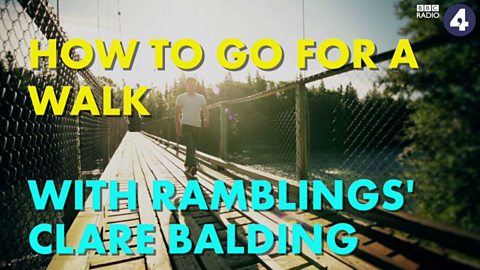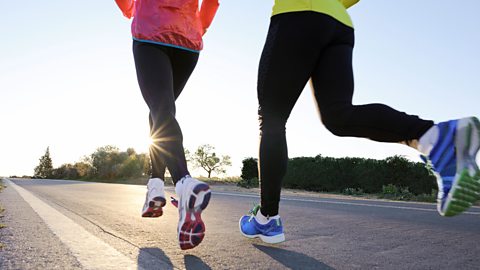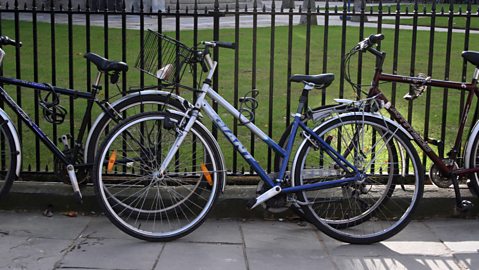Six steps to get more activity into your life
A sedentary, desk-bound, boxset-bingeing lifestyle is more dangerous than smoking.
by Professor Ulf Ekelund, of the Norwegian School of Sports Sciences and the University of Cambridge, that one hour of ‘brisk exercise’ should fend off the Grim Reaper for a spell. As we truly do want you to live forever (and keep listening to Radio 4 in the process), we’ve gathered together a selection of our most inspirational Radio 4 in Four clips to hopefully get you moving in a direction which is away from your inevitable demise…
1. Walking
The simplest, cheapest and easiest way to add a dash of much needed activity into your life. It can be simple as getting off the bus a couple of stops early, spending your lunch hour wandering around a local park or planning some multi-stage hiking extravaganza up Scafell Pike. Walking can help with depression, lower blood pressure and helps to protect your heart.
You’ll be joining famous walkers from history such as Charles Dickens (up to 20 miles at a time), Virginia Woolf (who loved her London parks) and George Orwell (who noted how far he’d walked in his diaries). Trapped in the office? Try taking the stairs rather than the lift or pop out to that coffee shop that’s slightly further away than your regular coffee shop. Still not sure? Try our guide on how to successfully have a walk.

How to go for a walk
Walking can give you time to think or an opportunity to explore.
2. Running
When ‘jogging’ became a fad in the 1970s, it was much-mocked and heartily disregarded. Now, no one would dare admit to jogging, while running has turned into something approaching a religion. It can certainly be daunting to the uninitiated, but it’s as simple as getting a decent pair of trainers, going at your own pace and not pushing yourself too hard or too often.
Perhaps you can even convince your workplace to install one of those new fangled treadmill desks? (OK maybe not) Or maybe you could try the odd gentle run into the office? (If they have showers). A 2012 study found that 30 minutes of running per week can improve sleep quality, mood, and concentration.The is a great way to get started, or listen to the inspirational tale of Vybarr Cregan Reid.

How to get into running
How much money should you spend on running shoes? Vybarr Cregan Reid answers questions.
3. Gardening
Not all activities have to involve investing in special equipment or mastering a new pursuit. Every keen gardener will readily tell you about its health benefits, both physical and mental. But now there’s scientific evidence that proves its benefits. Horticultural therapy is used in hospitals to treat patients, plan civic parks and gardens to improve cities and is even employed to calm prisoners.
One study showed that regular energetic gardening could provide the same positive health benefits as running or swimming. No garden? Look into allotments, conservation projects or guerrilla gardening groups in your local area. Or beg one of your work colleagues or friends into letting you come round and dig up their patio.

Should gardening be prescribed on the NHS?
Garden for therapy? The hobby can help people with physical and mental health problems.
4. Cycling
Much like running, some people take their cycling very, very seriously. Bikes that cost as much as cars, helmet cams, safety gear and acres of lycra - there’s plenty to get serious about. But cycling should be about fun and reconnecting with that joyful childhood feeling that only a good bike ride can inspire. There’s no need to go Bradley Wigginsning from the off - if you’re new or inexperienced, see if you can borrow a bike, then find a quiet spot to practice and build up confidence.
It’s excellent for health and eminently practical - getting you from A to B in an environmentally advantageous manner. And it’s the perfect way to get a bit of exercise as travel into, and more importantly away from, work. There’s a reason its the most popular form of transport on the planet. For further inspiration here’s author and life-long cyclist Rob Penn on why bicycles are so beloved.

Why we love the bicycle
Why lies behind its mass appeal? Rob Penn charts the bike's cultural and social impact.
5. Exercise with benefits
OK, so this particular activity might not be for everyone, but author David Sedaris, after trying a failing to cycle for fitness, took to litter picking around Sussex as a way to keep his Fitbit happy.
While spending hours fishing discarded plastic bags from treetops might not be everyone’s cup of tea, it does show that there are activities for all - you may just need to do some digging to find it. (Digging, that’s a good one)

David Sedaris: Litter picker
The American essayist on keeping Sussex tidy.
6. Make it fun
Convince your workplace that a weekly yoga or aerobic session would be beneficial. You could even try performing yoga with your dog (called doga, obviously), join a viking themed bootcamp group (where you pull anvils and lift barrels - just like the viking used to do) or even rave yourself to a better bod with ravercise!
Or, you could just go for a nice long walk. Whatever floats your boat.
Before you set off though, here is a clip with some information on what is the best food to fuel your activity...

What is the best food to eat before you exercise?
Does your body need you to eat less fat or fewer carbohydrates to exercise well?
More from Radio 4 in Four...
-
![]()
And... stretch! How do you feel today? Bit groggy? Is it hard to concentrate? You may be suffering from sleep deprivation.
-
![]()
When you go to the gym, or out for a run, do you use a gadget to monitor what you are doing? Different devices can reach some very different results.
-
![]()
Should we be worried about overdoing it when we're not used to exercising? Dr Mark Porter talks to Professor of Clinical Cardiology Sanjay Sharma and Dr Margaret McCartney to find out.
-
![]()
After all that exercise, maybe you're the type to order one the size of a dustbin lid covered in wildly unsuitable ingredients, so salty you'll wake up at 3am with a headache.




